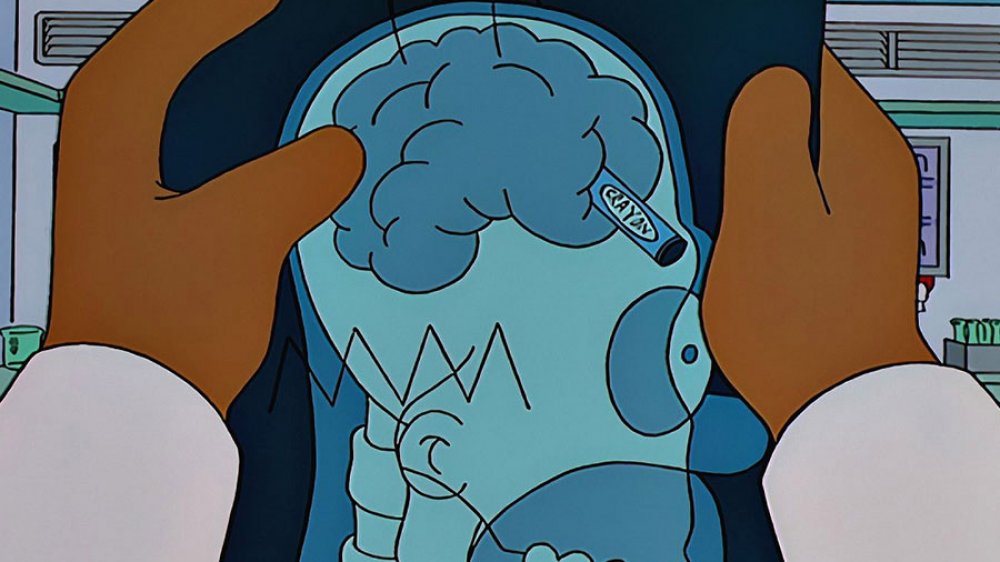Plot Holes In The Simpsons That Everyone Ignores
After more than three decades on the air, The Simpsons has long since established itself as a wild cartoon ride that's willing to cover almost every conceivable piece of sitcom ground. With so many talented writers dropping in and out of Springfield over the years, it's no surprise that there have been occasional plot holes here and there.
While some are forgivable for the sake of comedy — such as Homer's backyard being three feet away from his parking space at the nuclear plant for just one episode — others can leave even the most diehard Simpsons fan scratching his or her head.
For what it's worth, The Simpsons doesn't suffer from the sorts of glaring issues that plague pretty much any other long-running show. In fact, its continuity is often head and shoulders above lesser sitcoms that don't have the same impressive episode log. However, those shows also don't have The Simpsons' rabid fanbase waiting to point out major mistakes with a good old-fashioned Nelson Muntz "Ha-Ha!"
So, in the interest of exercising our inner Comic Book Guy, it's time to take a look at the Simpsons plot holes that fans have been forced to overlook for so long. To do that, it's worth taking a look back at the series and examining some of the problematic moments that everyone — except the most nit-picky of Simpsons fans — were willing to overlook.
The 'Simpsons Gene' skips someone
In the season 9 episode "Lisa the Simpson," Lisa begins to fear that her gift of intelligence is failing her. When she complains to Abe, he tells her that every member of the Simpson family starts out smart but then dramatically becomes dumber with age. This sends Lisa into an anxious spiral as she fears she'll soon become oafish like her father and brother.
When Homer realizes what his dad has done, he calls the extended family over to the house, where they discover that the gene only affects the Simpson men. A Dr. Simpson explains to Lisa that the defective gene is in the Y chromosome, meaning only boys get it — along with a rotund figure and a bald head. Although this makes Lisa feel better, it presents a giant plot hole in the form of Homer's previously introduced half-brother, Herb Powell.
The product of an affair between Abe and a woman named Gaby, Herb was put up for adoption in Shelbyville. When Homer meets Herb for the first time as an adult, he's introduced as a highly successful businessman who put himself through Harvard and climbed the ranks to start his own automotive company. In short, Herb is rich, intelligent, hardworking, successful, and has a mind for business. Essentially, he's all the things that Abe's genes were scientifically supposed to destroy as he got older. He even still has his hair and a somewhat trim figure, too. In short, the "Simpson Gene" clearly skipped Herb for unknown reasons.
Maude Flanders and Edna Krabappel exist in the future
In the season 6 episode "Lisa's Wedding," the family attends a fair where Lisa stumbles upon a fortune-teller and agrees to let the woman tell her the story of her first love.
For the first time in the show's history, the audience is presented with a flash-forward showing a 23-year-old Lisa embarking on a whirlwind romance with a young British student named Hugh Parkfield. Their wedding ceremony in Springfield is ill-fated after Hugh simply can't handle the oafish nature of Lisa's family; she calls off the wedding, but not before friends and family gather for the ceremony, including Maude Flanders and Edna Krabappel. Although it's the year 2010 at the time (15 years in the future from the episode's air date) fans know that both characters met unfortunate ends while Lisa was still in 2nd grade.
Maude was famously killed by a barrage of t-shirts that Homer provoked at a race car event when the velocity of the blow knocked her off the top of the raceway. That sent her husband, Ned Flanders, on a journey of grief in which he tried to figure out how to move on as a single father. That episode, "Alone Again, Natura-Diddily," aired in 2000, long before Lisa's future wedding would have taken place.
Ned would eventually move on with Krabappel, but when the voice actress who played her, Marcia Wallace, died in 2013, the show retired her character by killing Edna offscreen. As a result, both characters would not be able to attend 23-year-old Lisa's wedding.
Homer's family is fine with him giving himself brain damage
In the season 12 episode "HOMR," Homer subjects himself to medical testing after blowing the family's savings on a faulty investment. The doctors discover that Homer's complete lack of intelligence isn't biological at all, but rather the result of a crayon getting accidentally lodged into his brain after he attempted to stick an entire 16-pack up his nose as a child.
Homer's lack of intelligence was already explained through the "Simpson Gene" as a genetic predisposition to stupidity. However, when he agrees to let doctors remove the crayon, his IQ shoots up significantly. The intelligence that Homer gains endears him to his super-intelligent daughter, but makes him a villain around town. Realizing that he can't handle the burden that being smart brings upon a person, he enlists the help of unlicensed surgeon Moe Szyslak to insert a crayon back into his brain. Lisa briefly protests, but is subdued by a letter left behind by the intelligent version of her father.
However, Marge, Bart, and everyone else in Homer's life are never seen reacting to the fact that he clearly gave himself elective brain damage and now lives as an unintelligent burden on the rest of them. At no point does anyone do the sensible thing and implore him to consider the long-term effects. As a result, every moment of Homer's stupidity from that moment forward is not the charming oafishness of a cartoon character, but the choice of a selfish man with self-induced brain damage.
When did Homer and Marge get married?
Because The Simpsons has been on for 30 years without aging any of its characters, it can be hard to pin down the timeframe in which major events happened. While the show typically only hangs a lantern on this fact when it's played for comedy, all bets are apparently off when it comes to the timeline of Marge and Homer's relationship. In three key episodes, it is seemingly revealed that Marge and Homer's courtship lasted through the 1980s, 1990s, and early 2000s.
In the season 2 episode "The Way We Was," it's revealed that Homer and Marge met in 1974 while they were both attending Springfield High School. One season later, while telling the story of how Bart was born, it is implied that they conceived him after watching The Empire Strikes Back, which hit theaters in 1980. The two married while Marge was pregnant. However, in the season 19 episode "That '90s Show," Homer and Marge tell their kids the story of how they briefly separated in the early '90s (still before Bart was born and they were married). In that time, Homer invented grunge music while Marge pursued a romance with her college professor, which would mean she was attending college more than a decade after graduating high school.
All of that goes out the window in the season 29 episode "3 Scenes Plus a Tag from a Marriage," when Homer and Marge reveal that Bart was born while they were living in Capital City in the early 2000s.
Seymour Skinner cannot be Armin Tamzarian
When one talks about plot holes in The Simpsons, one has to talk about the woefully reality-busting season 9 episode "The Principal and the Pauper."
In this episode, it's revealed that the Seymour Skinner that the town of Springfield had grown to love was an imposter named Armin Tamzarian. When Armin got in trouble with the law while living as a street punk in Capital City, he was forced into the army, where he met the real Skinner. After Skinner was presumably killed in action, Tamzarian went to Springfield to break the news to his mother, only to be mistaken for his mentor. Unable to break the bad news, he lived as Skinner for the next 20 years. The episode ends with the town allowing Tamzarian to continue the ruse and agreeing to never speak of it again.
However, there's so much evidence that the man who says he's Tamzarian is irrefutably Skinner. First of all, because it's implied that Tamzarian delivers news of the real Skinner's death to his mother, it means he didn't stay in Vietnam long after. However, in the season 3 episode "Bart's Friend Falls in Love," it's revealed that he spent 18 months as a prisoner of war.
In addition, the season 7 episode "Raging Abe Simpson and his Grumbling Grandson in 'The Curse of the Flying Hellfish," it is revealed that Skinner's grandfather, Sheldon Skinner, was in Abe Simpson's platoon in World War II. When Sheldon is shown in a flashback, he appears to be an unmistakable relative of the man known as Tamzarian.
The Simpson family farm returns from the dead
At one point in the series, it is revealed that Homer grew up on a farm off of Rural Route 9. It's revealed in subsequent episodes that the family used to produce dairy until Homer spooked all the cows one day as a child and they stopped producing milk. Meanwhile, the rest of the land wouldn't grow anything.
After a fight with his dad in the season 6 episode "Grampa vs. Sexual Inadequacy," the father and son accidentally burn the house down completely. They even embrace on the porch after an argument as the rest of the farmhouse turns to rubble behind them. However, the old Simpson farm apparently doesn't stay burned down.
In the season 11 episode "E-I-E-I-D'oh," Homer becomes obsessed with challenging people to duels. However, when he brazenly challenges a southern dualist, Homer makes a quick escape from 742 Evergreen Terrace and brings his family to his old farmhouse, which is miraculously still standing with no explanation whatsoever.
The most obvious explanation is that someone rebuilt the farm. However, the episode goes out of its way to show that the townsfolk don't bother with the Simpson farm because they know that nothing will grow there. In addition, when the Simpson family pulls up in the episode, the farmhouse appears just as dilapidated and overgrown as a home that's been abandoned for decades should look.
The episode simply continues on and sees Homer invent the "refreshingly addictive" tomacco crop without ever letting the audience in on what happened with the fire.
Marge's fear of flying kicks in too late
In the season 6 episode "Fear of Flying," the Simpson family earns themselves a free trip anywhere in the continental United States in exchange for their silence about Homer's gross incompetence while impersonating a pilot. They're thrilled — except for Marge, who freaks out before takeoff, revealing a lifelong fear of flying.
The episode tackles this issue with Marge through therapy where it is revealed that she was disappointed in her father at a young age after figuring out that he was a male flight attendant and not a pilot like she thought. In addition, she also had repressed memories of being poked in the eye while being fed by the "airplane" as a baby and her toy ride-on airplane blowing up, as well as a memory of being shot at in a corfield by a low-flying plane.
In the end, Marge is able to get back on a plane, but it overshoots the runway and lands in the water. However, what makes this a glaring plot hole is the fact that Marge flew without incident in the season 3 episode "Mr. Lisa Goes to Washington."
Not only does Marge accompany the family on a flight, but their particular flight was likely triggering for anyone with a fear of flying — Bart made his way to the cockpit and released everyone's oxygen masks as a prank. All the same, Marge handles the flight well. She's still over her fear later in season 6, when the entire family travels to Australia.
The Simpsons return to Florida after being banned
In the season 11 episode "Kill the Alligator and Run," the Simpson family inadvertently takes a trip to Florida during Spring Break. Homer gets a little too wrapped up in the celebration and ends up accidentally running over the local community's mascot, an alligator named Captain Jack.
After a brief stint running from the law and being subsequently captured, the family is allowed to leave the state, provided that they never return. The episode ends with the Simpsons crossing Florida off a map of states they've been banned from, revealing that only Arizona and North Dakota remain.
However, their expulsion from Florida apparently doesn't last forever. In the season 14 episode "Special Edna," the family accompanies Bart's teacher to Orlando after he nominates her for a Teacher of the Year award and she subsequently wins. The family travels to and from the fictional EFCOT Center without incident. Yet again, in the season 15 episode "Catch 'Em if You Can," Homer and Marge make the hasty decision to go on a second honeymoon to Miami, prompting Bart and Lisa to give chase accompanied by Abe.
This certainly calls the map of all the states the family is banned from at the end of their spring break adventure into question, as it was either based completely on lies or simply unenforced by the states. It certainly proves, though, that Florida's decision to ban the Simpsons from the state forever was a toothless gesture.
Is Dr. Marvin Monroe dead or alive?
Dr. Marvin Monroe is a big loose end in The Simpsons canon. He first appeared in season 1 as the family's intrepid therapist. After failing miserably to fix the dysfunctional Simpson clan, Monroe made a handful of appearances before disappearing for years.
His name finally comes up again in "The Simpsons 138th Episode Spectacular" when host Troy McClure seemingly confirms Monroe's death when he is named in the trivia question "Which popular Simpsons characters have died in the past year?"
Although he wasn't the correct answer since he was "never popular," the line still confirmed his death. His passing is reaffirmed in subsequent episodes when it is revealed that a hospital and school gym were named after him. However, the most damning evidence comes in the episode "Alone Again, Natura-Diddily," when his gravestone is seen while the rest of the cast is attending Maude Flanders' funeral.
That's why it was so surprising when he arrived at Marge's book signing during the season 15 episode "Diatribe of a Mad Housewife." Even Marge is shocked to see him — he simply explains all of this away by saying he had "been very sick."
While that may explain his long absence, it doesn't explain why there is a hospital and school gym in his name, or why in the world there was a very opulent gravestone at Springfield Cemetery with his name on it.
Homer juggles multiple jobs constantly
It simply wouldn't be a good show if Homer Simpson wasn't able to try out one-off career opportunities every chance he gets. However, it does pose certain logistical problems for him, the family, and the show's sense of continuity.
The series poked fun at this plot hole in the season 13 episode where Homer takes up a job as a private security business that is eventually granted full policing powers over Springfield. As Marge does her nightly hair routine, Homer discusses his many occupations.
"You know, I've had a lot of jobs: Boxer, mascot, astronaut, imitation Krusty, baby proofer, trucker, hippie, plow driver, food critic, conceptual artist, grease salesman, carny, mayor, grifter bodyguard for the mayor, country-western manager, garbage commissioner, mountain climber, farmer, inventor, Smithers, Poochie, celebrity assistant, power plant worker, fortune cookie writer, Beer Baron, Kwik-E-Mart clerk, homophobe and missionary... but protecting Springfield, that gives me the best feeling of all."
How has Homer quit his power plant job and subsequently returned so many times throughout the years? It could be theorized that Homer is simply bad at his job and so low on the corporate ladder that no one notices his prolonged absences. Unfortunately, it's yet another plot eccentricity that the audience is asked to overlook in exchange for the classic and wacky antics that The Simpsons has become known for over the past three decades and counting.










